7kh 7ul flw\ v prvw dxwkhqwlf 7h[ 0h[ uhvwdxudqw ... - In Your Pocket
7kh 7ul flw\ v prvw dxwkhqwlf 7h[ 0h[ uhvwdxudqw ... - In Your Pocket
7kh 7ul flw\ v prvw dxwkhqwlf 7h[ 0h[ uhvwdxudqw ... - In Your Pocket
You also want an ePaper? Increase the reach of your titles
YUMPU automatically turns print PDFs into web optimized ePapers that Google loves.
142<br />
MALBORK<br />
The Castle<br />
The UNESCO-protected brick beast that is Malbork Castle<br />
came to prominence in 1309 when the Teutonic Knights<br />
moved into an already established albeit far smaller fort<br />
and turned it into their military and political headquarters.<br />
The largest brick castle in the world, which at its height<br />
covered a total of 21 hectares, was the centrepiece in what<br />
was once a ring of 120 castles surrounding the Teutonic<br />
Knights’ territory.<br />
The Poles failed to follow up their historic victory at Grunwald,<br />
but nonetheless the writing was on the wall for the<br />
knights. Mounting debts to pay for the upkeep of a largely<br />
mercenary army had spiralled out of control, and ultimately<br />
it was these unpaid knights who seized the fortress in a<br />
mutinous mood as payment for services rendered, before<br />
selling it on to the King of Poland in 1457. Their former<br />
leader, the disgraced Grand Master, was jeered out of<br />
town on a peasant cart as he made his final journey from<br />
his former stronghold.<br />
For the next three hundred years Malbork served as<br />
a Royal Residence, and became a stopover point for<br />
monarchs making the journey between Gdansk and<br />
Warsaw. This ended in 1772 when Poland was partitioned<br />
and Malbork fell under Prussian control. The<br />
castle was turned into a military barracks and a cotton<br />
workshop added to the Grand Masters Palace. For the<br />
next three decades old Malbork took a hammering, with<br />
cloisters and windows bricked up, gateways enlarged<br />
and outhouses dismantled. That the castle survived<br />
further attempts at ‘modernization’ was thanks only to<br />
a protracted campaign by the citizens of Berlin. Spurred<br />
by this public outcry the Prussian state embarked on<br />
Malbork <strong>In</strong> <strong>Your</strong> <strong>Pocket</strong><br />
something of a U-turn, and a huge programme of restoration<br />
was undertaken. The results were impressive,<br />
and by the early 20th century much of the castle had<br />
regained its original look.<br />
But the 20th century wasn’t kind to Malbork. On May 1,<br />
1933 the swastika was raised over the castle, and for the<br />
next twelve years it was to become a favourite haunt of highranking<br />
Nazis. Plans were drafted to build an amphitheatre<br />
in the castle grounds, and it was in the Great Refectory that<br />
Nazi Gauleiter Albert Forster made a landmark speech in<br />
1939 announcing that the territories on the left bank of<br />
the Wisla were to be incorporated into the Reich. Malbork’s<br />
grandeur wasn’t lost on the Nazis, and for the next few years<br />
its imposing courtyards and halls were used for swearing in<br />
ceremonies by the Hitler Youth and League of German Girls.<br />
With the tide of war turning steps were taken to protect<br />
Malbork, and in 1944 all stained glass was painstakingly<br />
removed. Even still, Malbork and its castle were smashed as<br />
the Marinenburg Task Force and 2nd Russian Strike Force<br />
faced off in 1945. Over half the castle was destroyed, and<br />
black and white pictures from the day show the castle as little<br />
more than a desolate set of ruins. With no hope in sight the<br />
retreating Nazis dynamited the bridges spanning the Nogat,<br />
and the Siege of Malbork was lifted.<br />
This all left Malbork in bad shape, with the brunt of the damage<br />
affecting the east side. Plundered by looters and abandoned<br />
by the state - who understandably had the unenvious<br />
task of rebuilding what was left of Poland - Malbork fell into<br />
abject decline. Finally, on January 1,1961, the Malbork Castle<br />
Museum was founded and restoration work given the green<br />
light. It was a huge effort, but the meticulous restoration work<br />
was finally rewarded in 1997 when the castle was recognized<br />
by UNESCO as a World Heritage Site.<br />
frombork.inyourpocket.com<br />
What to See<br />
Visible from 20km away Malbork is best appreciated by<br />
paying to cross over its northern drawbridge and spend<br />
an hour or two exploring its extraordinary interior. Made up<br />
of three distinctly different ensembles known as the High<br />
Castle, Middle Castle and Outer Bailey and surrounded by<br />
a vast dry moat, the most impressive sights all lie within<br />
the High Castle, the Brethren Knights’ original monastery,<br />
and the Middle Castle which served as the centre of the<br />
Teutonic Knights’ political activity. Among the jaw-droppingly<br />
awesome collection of buildings, impossible to miss are<br />
the 14th-century Palace of the Grand Masters, the original<br />
residence of the so-called Grand Master of the Teutonic<br />
Order. The vaulted interiors are marked by columns that fan<br />
out like palm trees, supposedly to remind the knights of their<br />
Palestinian roots, and it’s inside the main refectory you’ll find<br />
one such palm supporting an entire ceiling - a cannonball hole<br />
can be spotted on a nearby wall from when Polish soldiers<br />
tried to collapse the pillar. They missed by just the narrowest<br />
of margins, the result of their vandalism still in evidence.<br />
Also to visit is the breathtaking St. Mary’s Church, the Grand<br />
Masters’ final resting place and the impressive courtyard in<br />
the centre of the Middle Castle. Many rooms are open to the<br />
public, including during the summer a wonderful recreation<br />
of the Castle’s mill hidden away in a garden in the southwest<br />
corner of the High Castle. <strong>In</strong> contrast to the spartan, simple<br />
style of the Grand Masters Chambers the rest of the castle<br />
is a trove of treasures, and includes an enormous collection<br />
of weaponry as well as an amber exhibition. Other rooms<br />
are devoted to the Teutonic life and feature the requisite<br />
collection of armour, flags and goblets.<br />
Keep an eye out for the 112-page Illustrated Guidebook<br />
to Malbork Castle published by the Castle Museum by in<br />
Polish, German and English costing 26 zł and available in the<br />
tourist information and the Castle Museum shop.<br />
Malbork Castle (Zamek) B-3, ul. Starościńska 1,<br />
tel. (+48) 55 647 09 02, www.zamek.malbork.pl.Q<br />
Castle Open 09:00 - 20:00. Castle Museum Open 09:00<br />
- 19:00. Closed Mon. Tower Open 09:00 - 19:00. Admission<br />
39.50/29.50zł. From July admission 47.50/37.50zł.<br />
Prices include the choice of a place on a guided tour or an<br />
audioguide. Y<br />
Exhibition of Medieval Siege Engines (Wystawa<br />
Machin Oblężniczych) B-3, ul. Starościńska 1, tel.<br />
(+48) 601 37 78 02, www.zamekmalbork.pl. It’s appropriate<br />
that one of the most impressive castles in the<br />
world should have an exhibition of the type of equipment<br />
used against it. This collection is the largest of its type in the<br />
world and a wide range of equipment is on display including a<br />
Siege Tower. All of the equipment has been recreated using<br />
original materials and designs and some time spent here<br />
adds to the wonderful all-round experience of a day at one<br />
of the world’s most impressive Medieval fortresses. Q Open<br />
09:00 - 18:00. From June 26 open 10:00 - 19:00. Admission<br />
6/5zł, children under 5 free.<br />
Cemeteries<br />
Commonwealth War Cemetery (Cmentarz Brytyjskiej<br />
Wspólnoty Narodów) A-5, ul. 500-lecia.<br />
Located about 5km from the centre of town on the road<br />
to Kwidzyn, commemorating Commonwealth servicemen<br />
from both WWI and WWII and one of three similar<br />
cemeteries in Poland (the other two being in Poznań<br />
and Kraków), Malbork’s haunting Commonwealth War<br />
Cemetery features several rows of simple graves mark-<br />
malbork.inyourpocket.com<br />
MALBORK<br />
ing the final resting places of 14 British soldiers from<br />
WWI and 232 British, Canadian, Australian and New<br />
Zealand soldiers, sailors and airmen from WWII who<br />
either lost their lives on or over Polish soil or who died<br />
in the country as a POW.<br />
Soviet Army Cemetery (Cmentarz Wojenny<br />
Żołnierzy Armii Radzieckiej) A-5, ul. 500-lecia. A<br />
beautiful example of pompous Russian arrogance and the<br />
absurd mindset of the Soviet Union, this small cemetery<br />
came about as a way of celebrating the so-called liberation<br />
of Poland by the Red Army during the closing days of WWII.<br />
Specifically commemorating the Red Army soldiers who lost<br />
their lives liberating Malbork and the surrounding area, the<br />
cemetery in its current form dates from 1948 and features<br />
eight mass graves containing the remains of 529 soldiers<br />
who died in Malbork, Stare Pole, Zwierzno, Żurawiec and<br />
other parts of the region. A large concrete monument painted<br />
red takes pride of place, and is covered in typically heroic<br />
figures, acts and deeds.<br />
Restaurants<br />
Przystanek Patrzałkowie ul. Kościuszki 25, tel.<br />
(+48) 55 272 39 91, www.patrzalkowie.pl. Recommended<br />
to us as the best place to eat in Malbork we<br />
hadn’t visited at press time – something we aim to rectify<br />
in time for our August issue. The fact that the restaurant<br />
is an established family business and member of the Slow<br />
Food movement augur well and you can expect traditional<br />
Polish dishes which use the freshest, locally produced,<br />
seasonal produce. On top of that they do their own baking<br />
and we’ve been told to keep an eye out for their range of<br />
home produced cakes.QOpen 10:00 - 22:00. (12-25zł).<br />
TA6GBSW<br />
May - July 2012<br />
143
















